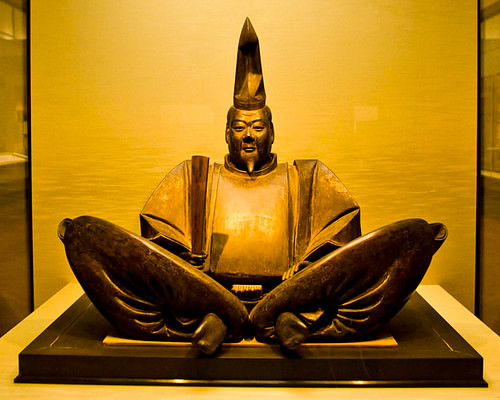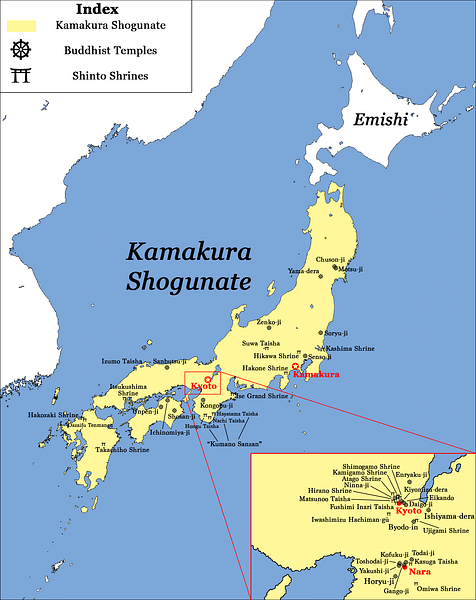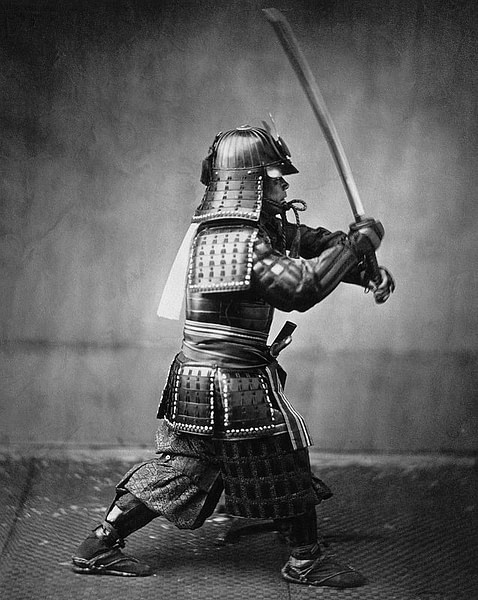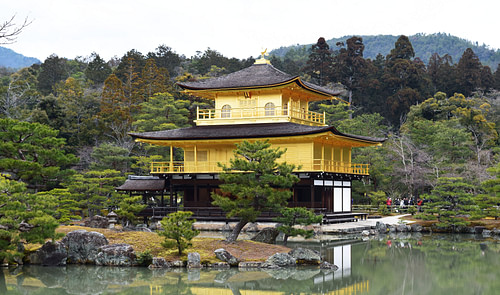Yoshimitsu Shoguns Associate With the Arts to Lend Their Shogunates Authority and Legitimacy
The shoguns of medieval Nippon were military dictators who ruled the country via a feudal system where a vassal'south armed services service and loyalty was given in return for a lord's patronage. Established as an institution by the offset shogun proper, Minamoto no Yoritomo in 1192 CE, the shoguns would rule for seven centuries until the Meiji Restoration of 1868 CE. The position of shogun was held by members of sure families which gave their names to two of the iii successive shogunate governments (bakufu): the Ashikaga Shogunate (r. 1338-1573 CE) and Tokugawa Shogunate (r. 1603-1868 CE). In the case of the first shogunate, the majuscule gave its proper name to the regime: the Kamakura Shogunate (r. 1192-1333 CE). The other shogunates may also exist referred to by their capitals: Muromachi (Ashikaga Shogunate), an area of Heiankyo/Kyoto, and Edo (Tokugawa Shogunate), the original proper name of Tokyo.
Between 1203 and 1333 CE regents ruled on behalf of shoguns who were nevertheless minors or who acted merely equally puppet figureheads. A last component in this dense political web was the Japanese emperor, largely powerless and restricted to ceremonial duties in the medieval period but still able to give legitimacy to shoguns by formally bestowing them their coveted title.
The Beginning Shogun: Minamoto no Yoritomo
The Genpei War (1180-1185 CE) saw the victory of the Minamoto clan over the Taira, and the leader of the former was Minamoto no Yoritomo, who thus became the most powerful military leader in Nihon. Yoritomo fabricated himself the first shogun, in issue military dictator, of Nippon, a position he would hold from 1192 CE to 1199 CE. He would, therefore, be the first shogun of the Kamakura Shogunate.
Technically, the emperor was in a higher place the shogun, but in exercise, it was the reverse as whoever controlled the ground forces as well controlled the state.
The position of shogun was the first to offering an alternative organisation of authorities to that of the Japanese imperial court. The title of shogun or 'military machine protector' had been used before (seii tai shogun) but had only been a temporary title for military machine commanders on campaign against the Ezo/Emishi (Ainu) in the withal-disputed territory in the north of Japan during the 8th century CE. In that context, the title shogun translated every bit 'barbarian-subduing generalissimo.' The championship of shogun was actually showtime resurrected past Yoritomo's cousin, Minamoto Yoshinaka (1154-1184 CE), who commanded the clan's forces in Heiankyo in 1183 CE, although he did non receive information technology from the emperor, as was the tradition.
Yoritomo was able to hold the championship of shogun with its new wider pregnant thanks to his understanding with the young Emperor Become-Toba (r. 1183-1198 CE) who bestowed information technology in return for Yoritomo'due south armed forces protection. Technically, the emperor was above the shogun, merely in practice, it was the contrary as whoever had control of the army also controlled the state. The emperors did maintain a ceremonial function, and their endorsement was still sought by shoguns to give a veneer of legitimacy to their own rule. Indeed, the fact that the emperor gave the championship bestowed upon the shogun his status as 'protector of the nation', a very useful idea which meant he could use anyone and whatever means for whatever purpose he saw fit. Emperors could delay a shogun'due south engagement but not indefinitely. It was also the case that the championship of shogun at this stage in Nippon's history was non as prestigious as it would become in the 13th century CE, a fact illustrated by Yoritomo's desire to acquire many other traditional court ranks besides, notably udaisho (Captain of the Correct Sectionalization of the Inner Palace Guards).

Minamoto no Yoritomo Statue
Yoritomo was succeeded as shogun by his eldest son Minamoto no Yorie (r. 1202-1203 CE), but but after a power struggle. When Yoritomo died, his wife, Hojo Masako (1157-1225 CE), and her male parent, Hojo Tokimasa, had decided to rule themselves, and so they created the position of shogunal regent (shikken) and promoted the interests of the Hojo association. In this arrangement, much copied throughout the Kamakura Menstruation (1185-1333 CE), the regent shogun had the real power and the shogun was a mere puppet, each one picked by the Hojo. It also allowed a regent to bypass the requirement that a shogun had to come up from the warrior form and and then achieve a position of power otherwise unavailable to them.
The lack of any written description apropos the precise role of the shogun and the absence of whatsoever legal definition now meant that the function was easily manipulated by a long line of regents - xvi from 1203 to 1333 CE - to fit their ain purposes; it was not the shogun who ruled Japan merely the shogunate government. This situation would not change until the institution of the Ashikaga Shogunate in 1338 CE when regents became a thing of the past and the shogun over again was the real leader of the country. Even so, though, a regime apparatus was in place which shared out power to prominent members of Japan's military class.
Shogunate Authorities
The shogunate government, also known as bakufu, which means 'tent government' in reference to its origins as a title held by a commander in the field, was based on the feudal human relationship betwixt lord and vassal. At the elevation of the social and political pile was the shogun or regent shogun who distributed land to loyal followers in return for their armed forces service (both personal and of their individual private armies of samurai).

Major Temples and Shrines of Nippon circa 1200 CE, Kamakura Shogunate
The shogun was assisted in the practicalities of authorities by various ministers, officials, and institutions. Many of these were added to the government apparatus over fourth dimension equally information technology became always more complex. Foremost amongst these was the deputy shogun (kanrei), usually a position held on a rotation ground by a member of one of iii families: the Shiba, Hosokawa, and Hatakeyama. The role was created from 1333 CE, and a key function was to human action as a liaison between the shogun and regional military governors and their deputies.
In 1180 CE the Samurai-dokor (Board of Retainers) was formed, which supervised vassal warriors (gokenin) and dished out disciplinary measures for whatever misdemeanours. Later, it would also supervise government agents in the provinces, the shogunate'south ain property, and the security of Heiankyo. The imperial court at the capital was supervised past the Kyoto shugo or military governor, a position replaced past the Rokuhara deputy from 1221 CE. Potential trouble spots far from the capital and government headquarters such as Kyushu and Oshu each had their ain special commissioners.
To ensure the shogunate's rule extended to all territories, two important local offices were created - shugo (lawman) & jito (steward).
In 1184 CE the Kumonjo (Public Documents Role) was established. This was and then renamed and widened in role equally the Mandokoro (Administrative Board) in 1191 CE as it became the main executive and administration center of the government. Afterward yet, it would be given accuse of the state treasury. Likewise in 1184 CE, the Monchujo (Lath of Research) was set up which looked later on all legal matters including lawsuits, appeals, disputes over land rights and loans.
A new position, a vice-regent to the shogun (rensho) was created in 1225 CE, and official documents then required both his and the regent shogun's signature. Also in 1225 CE, the Hyojoshu (Council of State) was formed, which had every bit its members the tiptop officials, warriors, and scholars of the moment. They voted on issues with a simple bulk winning the day. In 1232 CE a new police force code was established, the Joei Code (Joei shikimoku), which had 51 articles and established who owned what country, divers the relationship between lords, vassals, and samurai, limited the office of the emperor, and established the taking of legal decisions based on precedence. Finally, in 1249 CE a High Court, the Hikitsukeshu, was formed which was particularly concerned with whatsoever disputes related to state and taxes.

Samurai
To ensure the shogunate's rule extended to all territories, 2 of import local offices were created: shugo and jito. A shugo was a military governor of a province with policing duties (hence he is ofttimes called a constable) while a jito was responsible for collecting taxes from individual estates (and so is sometimes called a steward). Over time both positions would evolve and become hereditary; many of the daimyo, the powerful feudal lords of medieval Nippon, had ancestors who had performed these duties. Some daimyo would command such vast estates that they were, in issue, princedoms, and these men would seriously challenge the power of the shogunate authorities.
Patrons of the Arts
While the imperial court was based at Heiankyo during the medieval menstruation, the shogun's government inverse location depending on his choice of city. Kamakura was the seat of the shogunate from 1192 to 1333 CE, while the Ashikaga Shogunate was based in the Muromachi expanse of Heiankyo, and the Tokugawa Shogunate in Edo. These moves brought cultural as well equally political consequences considering shoguns wished to beautify their new capital. Consequently, fine palaces, temples, and new art schools sprang up. Many shoguns, peculiarly when they retired from public office, became great patrons of the arts, commissioning painters and sculptors, sponsoring performances of Noh theatre, and perpetuating the aristocratic fashion for the Japanese Tea Ceremony.
The shogun Ashikaga Yoshimitsu (r. 1368-1394/5 CE) built the famous Kinkakuji or 'The Temple of the Gold Pavilion' in 1397 CE, originally every bit his rather gaudy retirement abode, but information technology was later on converted to a Zen Buddhist temple. Another addition to Kyoto's palaces that followed the same pattern of utilise was fabricated by Ashikaga Yoshimasa (r. 1449-1474 CE) who built the Ginkakuji or 'The Serene Temple of the Silver Pavilion', completed in 1483 CE. Another surviving architectural gem from Japan'south medieval past is Kyoto'due south Nijo castle, built by the shogun Tokugawa Ieyasu from 1603 CE. Shoguns were not averse to a bit of restoration piece of work either, oft ploughing money into temple sites, particularly after the many fires that burnt and so many down over the centuries. Tokugawa Iemitsu (r. 1623-1651 CE), for case, fully restored Kyoto's celebrated Buddhist temple Kiyomizu-dera in 1633 CE and even added a new pagoda for good measure.

Kinkakuji Temple in Kyoto, Japan
Challenges & Reject
There were occasional challenges to the shoguns such as the attempted coup by Emperor Go-Toba in 1221 CE - the so-chosen Jokyu Disturbance which ended in the emperor's exile. Another unsuccessful imperial challenge was the Kemmu Restoration (1333-1336 CE) of Emperor Become-Daigo (r. 1318-1339 CE) which only replaced one shogunate with some other. There were threats from abroad, also. The Mongol leader Kublai Khan (r. 1260-1294 CE) decided to invade Nihon in 1274 and 1281 CE, but both times Japanese resistance and typhoon storms combined to save the land.
The next major challenge to shogunate authorization was again internal. The Onin War (1467-1477 CE) was a civil war between rival warlords and it brought much expiry and destruction, especially at Heiankyo. There and so followed a century of bitter fighting and unrest, the so-called Sengoku Period or Warring States Period (1467-1568 CE). This turmoil finally ended with the ascension of the warlord Oda Nobunaga (fifty. 1534-1582 CE). Oda Nobunaga had expanded his territory gradually through the 1550/60s CE from his base at Nagoya Castle as he defeated all comers. He finally seized Heiankyo in 1568 CE and and so exiled the last Ashikaga shogun, Ashikaga Yoshiaki, in 1573 CE.
Nobunaga's takeover heralded the Azuchi-Momoyama Period (1568/73 - 1600 CE) and his two firsthand successors, as well powerful warlords, would likewise sideline the shoguns to the very backseat of Japanese politics. These successors were Toyotomi Hideyoshi (r. 1582-1598 CE) and Tokugawa Ieyasu (r. 1603-1605 CE) and the trio are considered the corking unifiers of Nihon, finally forging the single state that entered the pre-mod era. The Tokugawa Shogunate based at Edo would rule from 1603 CE and keep until January 1868 CE. Then, after years of ineffectual authorities and failure to meet the threat of foreign powers like Great britain and the United States, the Meiji Restoration finally abolished the position of shogun and restored full powers to the emperors.
This content was made possible with generous support from the Great Great britain Sasakawa Foundation.
This article has been reviewed for accuracy, reliability and adherence to academic standards prior to publication.
copelandwhimptiessir63.blogspot.com
Source: https://www.worldhistory.org/Shogun/
0 Response to "Yoshimitsu Shoguns Associate With the Arts to Lend Their Shogunates Authority and Legitimacy"
إرسال تعليق